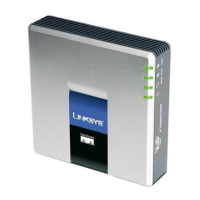Linksys Voice System Administration Guide 76
Managing Inbound Calls with Hunt Groups
Configuring Phone Lines and Calling Routing Behavior
Examples of “Ring Individual Stations” Hunt Group Rules
• “From the Beginning” Order with Forwarding to the Auto Attendant
300:name=TechSupport,101,102,100,hunt=re;20;2,cfwd=aa
This hunt group is assigned an extension number (300:) and a name
(
name=TechSupport,). The group includes three stations (101,102,100,). Calls are routed
sequentially from the beginning of the list (
hunt=re;). Every new call is routed to station
101. If the call is unanswered, it cycles to station 102 and then to station 100. Each
phone rings for 20 seconds (
20;). After 2 cycles elapse, an unanswered call is forwarded
to the Auto Attendant (
, cfwd=aa).
• Random Order with Forwarding to a Voice Mailbox
400:name=Sales,101,102,103,hunt=ra;30;1,cfwd=vm2100
This hunt group is assigned an extension number (400:) and a name (name=Sales,). The
group includes three stations (
101,102,103,). Calls are routed in random order (hunt=ra;).
A new call is routed to a randomly chosen station. If the call is unanswered, it cycles
through the stations in random order. Each phone rings for 30 seconds (
30;). After 1
cycle is completed, an unanswered call is forwarded to the voice mail for station 100,
where Line 2 is configured for the voice mail service (
1,cfwd=vm2100).
• “Next Station” Order with Forwarding to a Station
500:name=Scheduling,102,103,101,hunt=ne;45;240,cfwd=100
This hunt group is assigned an extension number (500:) and a name (name=Scheduling,).
The group includes three stations (
102,103,101,). Calls are routed in “next station” order
(h
unt=ne;). Suppose that station 103 answered the most recent call. A new call is routed
to the next station in the list, which is station 101. If the call is unanswered, then it cycles
to station 102, and so on. Each phone rings for 45 seconds (
45;). After a total of 240
seconds has elapsed, the call is forwarded to station 100 (2
40,cfwd=100).
• Multiple Lines with Wildcard Characters
400:name=CustomerService,10?,hunt=re;20;2,cfwd=aa|500:name=Sales,20?,hunt=ra;30;1,
cfwd=vm100| 600:name=TechSupport,300,301,302,hunt=ne;45;3,cfwd=100|
Three hunt groups are created. A call to extension 400 rings stations 100 to 109 in “from
the beginning order.” A call to extension 500 rings stations 200 to 209 in random order.
A call to extension 600 rings the listed stations in “next station” order.
Creating a Hunt Group to Ring Individual Stations
1. Connect to the SPA9000 administration web server, and choose Admin access with
Advanced settings. (See ”Connecting to the SPA9000 Administration Web Server,” on
page 24.)
2. Click Voice tab > SIP.
3. Scroll down to the PBX Parameters section.

